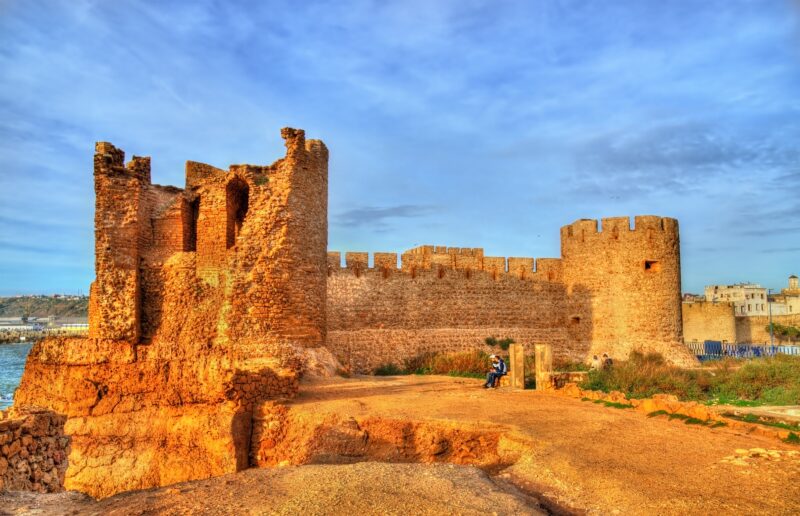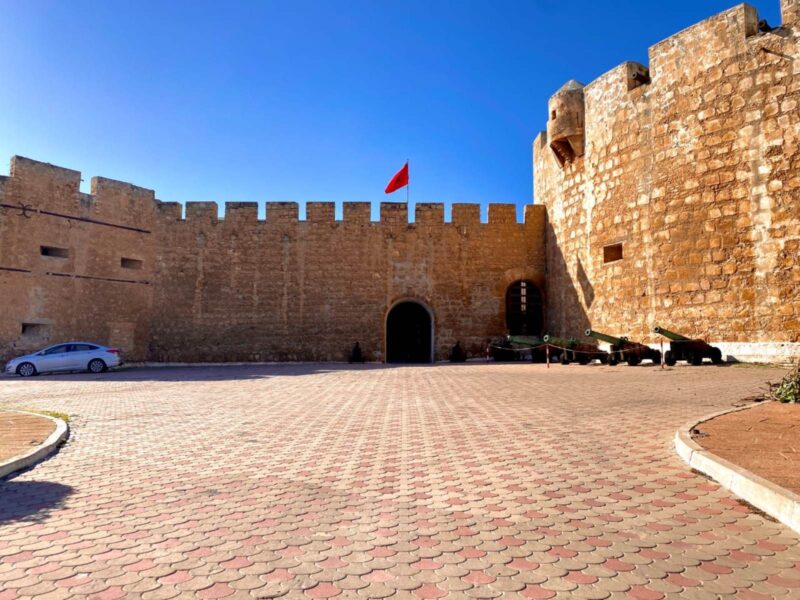Safi, whose name comes from the Amazigh language and means ‘mouth of the river’ (estuary), is both traditional and modern. Its economy is based on numerous fish-processing factories and ceramics shops.
Safi
Safi, originally a Canaanite settlement, has seen a multitude of rulers over the centuries, including the Carthaginians, Romans, Goths, and Arab Muslims. Under Portuguese rule in the 16th century, it endured a period of taxation and governance, only to be liberated and rebuilt by Sheikh Muhammad Al-Saadi. Flourishing during the 16th and 17th centuries under the Saadian sultans, Safi became a pivotal port city.
However, with the Alawite sultans relocating their capital to Rabat, Safi’s importance gradually diminished. Despite this, the city experienced significant population growth, emerging as a vital center for fishing, sardine exportation, and foodstuff handling. Additionally, Safi became renowned for its chemical industries, pottery, and educational institutions, boasting a unique blend of medieval and modern architectural styles, including historic mosques and schools dating back centuries.
Dar Al Bahar
Its ancient history, deeply rooted in civilizations, enabled it to have many monuments that remain steadfast to this day, including the “Palace of the Sea,” one of the most important historical monuments in the city of Safi, located along Independence Square. This Portuguese landmark was built in the 15th century AD to form A small Portuguese fortress, then the governor’s seat; completely renovated in 1963, it has a large monumental gate opening onto a parade ground containing ten ancient bronze cannons aimed at the ocean.
Portuguese cathedral
The Portuguese cathedral is also part of the city’s ruins. It was built by the order of the Portuguese King Emmanuel I in 1519 as a gift for his wife, Queen Saint Catherine. It was built by Joao Louis and is still witness to a historical era in which the Portuguese imposed their authority on some ports in North Africa.
Dar Soltane
The city contains the “Dar Soltane,” a castle that dates back to the Almohad period (the twelfth to the thirteenth century AD). It protected the city because it overlooks the sea palace and the Atlantic Ocean. The castle became a tourist residence for Alawite kings and princes who built a house called “Bahia,” hence the name Dar Al-Sultan. In 1990 the court was turned into a national museum of ceramics.
Where to Stay in Safi
Hotel Atlantique Panorama
A hotel right on the beach with beautiful views of the ocean, cozy rooms, and a calm atmosphere that’s great for travelers who want to relax.
Riad Le Cheval Blanc
A charming riad in the middle of the medina with traditional Moroccan decor, a rooftop terrace, and individual service to make your stay feel like home.
Hotel Farah Safi
This long-standing hotel has large rooms, a swimming pool, and lovely views of the Atlantic. It’s good for both work and pleasure travelers.
Ryad du Pêcheur
A cozy guesthouse with a friendly vibe that is close to the coast and has beautiful rooms and a deck where guests can enjoy the sea breeze.
Exploring the Culture of Safi
Local Culture: The city’s customs are a mix of Amazigh, Arab, and European styles, resulting from its long history. The medina, busy souks, and artisan workshops reflect this rich history. Local traditions stress community and hospitality.
Food: Tagines, seafood dishes, and couscous are traditional Moroccan recipes. People often use spices like saffron, cumin, and cinnamon, and they love street food like grilled sardines and semen (Moroccan pancakes).
Music: Gnawa rhythms, Andalusian melodies, and Amazigh folk tunes are all traditional music. Live performances with drums, string instruments, and soulful singing are common at local festivals., making for an immersive cultural experience.
Clothes: The djellaba is a traditional garment that looks like a long coat with a hood. People wear kaftans for important events. Women often wear jewelry and bright scarves to dress up. In contrast, men usually wear pandoras or tunics, especially to cultural events.
Things to Do in Safi
Explore the Pottery Area
Safi is known for its pottery, and you should visit one of the workshops. Artists in the city paint beautiful things by hand, and you can watch them work or even buy one-of-a-kind gifts.
Pay a visit to Kechla Fortress
From this old castle, you can see the city and the Atlantic Ocean beautifully. It was built when Portugal ruled the area and is now a cultural landmark and a great place for history buffs to visit.
Go to Lalla Fatna Beach
Lalla Fatna Beach is just outside the city and is a great place to rest, surf, or take in the view of the coast. Surfers come to enjoy the waves, and the golden sands make it a peaceful place to relax.
Discover the Medina and Souks
The old medina in Safi is busy with antique shops, craft shops, and people selling fresh fish. Walking through its narrow streets gives visitors a real feel for Moroccan everyday life.
Best Time to Visit Safi
The best times to visit Safi are spring (March to May) and fall (September to November). The weather is mild (18°C to 26°C, or 64°F to 79°F), so it’s a great time to visit the medina, pottery workshops, and historical places. The mild weather also makes outdoor activities like going to the beach and seeing places more enjoyable.
Summer can be hot from June to August, but the ocean breeze keeps things cool. This is the best time to visit Safi’s beaches and surf spots because the weather is usually between 22°C and 30°C (72°F and 86°F). However, it can get crowded with people from all over the world.
The weather is cooler but still lovely, between 12°C and 20°C (54°F to 68°F) in the winter (December to February). Even though it might be too cold to swim in the sea, this time of year is peaceful and quiet, making it ideal for exploring culture and taking pictures.
How to Get to Safi
By Plane
Marrakech Menara Airport is about 150 km from Safi, and Mohammed V International Airport in Casablanca is about 300 km away. You can take a train, a bus, or a car from these airports to Safi.
By Train
If you want to take a long-distance train, you can’t go straight to Safi. But you can go to nearby towns like Marrakech or Casablanca and then take a bus or car to get to Safi. The ONCF railway system lets you get to these towns from many places.
By car
Marrakech (150 km, about 2.5 hours) and Casablanca (300 km, about 3.5 hours) are close enough to drive to Safi. The road is in good shape, and driving is a good choice for more freedom and comfort.
By Taxi
You can take a taxi to Safi from places like Marrakech and Casablanca. It may be more expensive than taking the bus or train, but a private cab ride is faster and more tailored to your needs.





